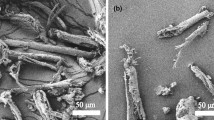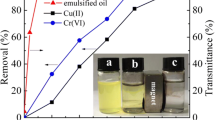Abstract
Extractant leakage has been a limiting factor in the recovery of metal ions from conventional emulsion gels in water. Pickering emulsion hydrogels (PEHGs) were prepared by oil-in-water Pickering emulsion polymerization with diacetone acrylamide and acrylamide as the continuous phase, indium(III) extractant (bis(2-ethylhexyl) phosphate) as the dispersed phase, and nano-silica (SiO2) as the emulsifier. The Pickering emulsions were characterized by optical microscopy, and the PEHGs were characterized by infrared spectroscopy and scanning electron microscopy. The In(III) adsorption properties of the PEHGs were investigated. The results showed that the highest In(III) adsorption capacity of PEHGs reached 25.14 mg g−1 at 25 °C. The adsorption amount of In(III) was consistent with the predicted value from the Langmuir isotherm model. After three cycles of adsorption and desorption, the In(III) adsorption rate remained at about 98% and there was no obvious oil phase leakage. These findings demonstrate that PEHGs have excellent encapsulation properties and show potential as a recyclable material for highly efficient removal of In(III). Additionally, PEHGs offered a new strategy for environmental management and economic development due to its green and convenient manufacturing.
Graphical abstract
Pickering emulsion hydrogels could be used for indium ion recovery as adsorption material with high encapsulation performance and stability.











Similar content being viewed by others
Data availability
The data that support the findings of this study are available from the corresponding author, upon reasonable request.
References
Albert C, Belad**e M, Tsapis N, Fattal E, Agnely F, Huang N (2019) Pickering emulsions: preparation processes, key parameters governing their properties and potential for pharmaceutical applications. J Control Release 309:302–332
Anna M, Petr B (2015) Analysis of Czech subsidies for solid biofuels. Int J Green Energy 12(4):405–408. https://doi.org/10.1080/15435075.2013.841163
Bao S, Tang Y, Zhang Y, Liang L (2016) Recovery and separation of metal ions from aqueous solutions by solvent-impregnated resins. Chem Eng Technol 39(8):1377–1392. https://doi.org/10.1002/ceat.201500324
Bao Y, Xue H, Yue Y, Wang X, Yu H, Piao C (2021) Preparation and characterization of pickering emulsions with modified Okara insoluble dietary fiber. Foods 10(12):2982
Brinkmann KO, Becker T, Zimmermann F et al (2022) Perovskite–organic tandem solar cells with indium oxide interconnect. Nature 604(7905):280–286. https://doi.org/10.1038/s41586-022-04455-0
Chen L, Ao F, Ge X, Shen W (2020) Food-grade Pickering emulsions: preparation, stabilization and applications. Molecules 25(14):3202. https://doi.org/10.3390/molecules25143202
Dileepa Chathuranga P, Priyantha N, Iqbal SS, Iqbal M (2013) Biosorption of Cr (III) and Cr (VI) species from aqueous solution by Cabomba caroliniana: kinetic and equilibrium study. Environmental Earth Sciences 70(2):661–671. https://doi.org/10.1007/s12665-012-2150-9
Drzazga M, Palmowski A, Benke G, Ciszewski M, Leszczyńska-Sejda K (2021) Recovery of germanium and indium from leaching solution of germanium dross using solvent extraction with TOA, TBP and D2EHPA. Hydrometallurgy 202:105605. https://doi.org/10.1016/j.hydromet.2021.105605
Dwivedi CD, Dey AK (1968) Photometric determination of trivalent gallium, indium and thallium with Xylenol orange. Microchim Acta 56(4):708–711. https://doi.org/10.1007/BF01216908
Fortin-Lecomte C, Tran L-H, Rioux G, Coudert L, Blais J-F (2022) Recovery of indium from acidic leach solutions of spent LCD panels using ion exchange. Hydrometallurgy 210:105845
Gao L, Dai Z, Wu H, Wu C, Wan Y (2022) Study on efficient extraction of indium from complex sulfuric acid solution by “ionic liquid + di(2-ethylhexyl)phosphoric acid + tributyl phosphate.” Sep Purif Technol 288:120670. https://doi.org/10.1016/j.seppur.2022.120670
Gonzalez Ortiz D, Pochat-Bohatier C, Cambedouzou J, Bechelany M, Miele P (2020) Current trends in Pickering emulsions: particle morphology and applications. Engineering 6(4):468–482. https://doi.org/10.1016/j.eng.2019.08.017
Kamio E, Kondo K (2002) Separation of rare metal ions by a column packed with microcapsules containing an extractant. Ind Eng Chem Res 41(15):3669–3675. https://doi.org/10.1021/ie010737c
Lagaly G, Reese M, Abend S (1999) Smectites as colloidal stabilizers of emulsions: II. Rheological properties of smectite-laden emulsions. Appl Clay Sci 14(5):279–298. https://doi.org/10.1016/S0169-1317(99)00004-6
Liu F, Liang X, Yan J, Zhao S, Li S, Liu X, McClements D J (2022). Tailoring the properties of double-crosslinked emulsion gels using structural design principles: Physical characteristics, stability, and delivery of lycopene. Biomaterials 280: 121265. https://doi.org/10.1016/j.biomaterials.2021.121265
Maroušek J (2014) Biotechnological partition of the grass silage to streamline its complex energy utilization. Int J Green Energy 11(9):962–968. https://doi.org/10.1080/15435075.2013.833930
Maroušek J, Trakal L (2022) Techno-economic analysis reveals the untapped potential of wood biochar. Chemosphere 291:133000. https://doi.org/10.1016/j.chemosphere.2021.133000
Meena VS, Mehata MS (2022) Thermally grown indium (In) thin-film for creating ohmic contact and In-bumps for HgCdTe-based IR detectors. Appl Surf Sci 596:153501. https://doi.org/10.1016/j.apsusc.2022.153501
Pickering SU (1907) Cxcvi.—emulsions. J Chem Soc Trans 91:2001–2021. https://doi.org/10.1039/CT9079102001
Ramsden W (1904) Separation of solids in the surface-layers of solutions and ‘suspensions’(observations on surface-membranes, bubbles, emulsions, and mechanical coagulation).—Preliminary account. Proc Royal Soc London 72:156–164. https://doi.org/10.1098/rspl.1903.0034
Regazzoni AE (2020) Adsorption kinetics at solid/aqueous solution interfaces: On the boundaries of the pseudo-second order rate equation. Colloids Surf A Physicochem Eng Asp 585:124093. https://doi.org/10.1016/j.colsurfa.2019.124093
Revellame ED, Fortela DL, Sharp W, Hernandez R, Zappi ME (2020) Adsorption kinetic modeling using pseudo-first order and pseudo-second order rate laws: a review. Clean Eng Technol 1:100032. https://doi.org/10.1016/j.clet.2020.100032
Sivaran**i B, Umadevi S, Khan RK, Pratibha R, Dekshinamoorthy A, Vijayaraghavan S, Ganesh V (2022) Planar and vertical alignment of rod-like and bent-core liquid crystals using functionalized indium tin oxide substrates. Liq Cryst 49(7–9):1246–1260. https://doi.org/10.1080/02678292.2021.1995061
Sun Z, Yan X, **ao Y, Hu L, Eggersdorfer M, Chen D, Yang Z, Weitz DA (2021) Pickering emulsions stabilized by colloidal surfactants: role of solid particles. Particuology. https://doi.org/10.1016/j.partic.2021.06.004
Tokuyama H, Yoshida T, He L (2011) Preparation of novel emulsion gel adsorbents and their adsorption properties for heavy-metal ions. Ind Eng Chem Res 50(17):10270–10277. https://doi.org/10.1021/ie201179n
Van Nguyen N, Lee J-c, Jeong J, Pandey BD (2013) Enhancing the adsorption of chromium(VI) from the acidic chloride media using solvent impregnated resin (SIR). Chem Eng J 219:174–182. https://doi.org/10.1016/j.cej.2012.12.091
Wang H, Gu Y, Wu Y, Zhang Y-N, Wang W (2015) An evaluation of the potential yield of indium recycled from end-of-life LCDs: a case study in China. Waste Manag 46:480–487. https://doi.org/10.1016/j.wasman.2015.07.047
Wang Q, Wang B, Lee X, Lehmann J, Gao B (2018) Sorption and desorption of Pb(II) to biochar as affected by oxidation and pH. Sci Total Environ 634:188–194. https://doi.org/10.1016/j.scitotenv.2018.03.189
Wang H, Zhu J, Tan L, Zhou M, Zhang S (2020) Encapsulated ionic liquids for CO2 capture. Mater Chem Phys 251:122982. https://doi.org/10.1016/j.matchemphys.2020.122982
Xuezhen Gao SW, Cao P (2017) Study on the adsorption of indium (III) by P507/D301 impregnated resin. J Ludong Univ 33(4):340–345. https://doi.org/10.3969/j.issn.1673-8020.2017.04.010
Yang Y, Fang Z, Chen X, Zhang W, **e Y, Chen Y, Yuan W (2017) An overview of Pickering emulsions: solid-particle materials, classification, morphology, and applications. Front Pharmacol 8:287. https://doi.org/10.3389/fphar.2017.00287
Yen F-C, Chang T-C, Laohaprapanon S, Chen Y-L, You S-J (2016) Recovery of indium from LCD waste by solvent extraction and the supported liquid membrane with strip dispersion using D2EHPA as the extractant. Solvent Extr Res Dev Jpn 23(1):63–73
Yuan S, Liu Q, Liang Y, Ning K, Yu X, He Y (2021) Dual 3-D networked Pickering emulsion hydrogels encapsulating copper extractants for the recovery of Cu2+ from water. J Environ Chem Eng 9(2):105154. https://doi.org/10.1016/j.jece.2021.105154
Zhang Y, Kogelnig D, Morgenbesser C, Stojanovic A, Jirsa F, Lichtscheidl-Schultz I, Keppler BK (2011) Preparation and characterization of immobilized [A336][MTBA] in PVA–alginate gel beads as novel solid-phase extractants for an efficient recovery of Hg (II) from aqueous solutions. J Hazard Mater 196:201–209. https://doi.org/10.1016/j.jhazmat.2011.09.018
Zhang T, Sanguramath RA, Israel S, Silverstein MS (2019) Emulsion templating: porous polymers and beyond. Macromolecules 52(15):5445–5479. https://doi.org/10.1021/acs.macromol.8b02576
Acknowledgements
This work was supported by the National Natural Science Foundation of China (No. 50572088).
Funding
This work was supported by the National Natural Science Foundation of China (No. 50572088).
Author information
Authors and Affiliations
Contributions
CD contributed to methodology, writing—original draft, and data curation. JG and YZ contributed to visualization and investigation. WZ contributed to software and funding acquisition. KN contributed to resources and formal analysis. PW contributed to formal analysis and validation. YH contributed to conceptualization, methodology, writing—review & editing, and project administration.
Corresponding authors
Ethics declarations
Conflict of interest
The authors have no relevant financial or non-financial interests to disclose.
Additional information
Publisher's Note
Springer Nature remains neutral with regard to jurisdictional claims in published maps and institutional affiliations.
Rights and permissions
Springer Nature or its licensor (e.g. a society or other partner) holds exclusive rights to this article under a publishing agreement with the author(s) or other rightsholder(s); author self-archiving of the accepted manuscript version of this article is solely governed by the terms of such publishing agreement and applicable law.
About this article
Cite this article
Dong, C., Gao, J., Zhao, Y. et al. Preparation of Pickering emulsion hydrogels containing indium(III) extractants and their indium(III) recycling properties. Clean Techn Environ Policy 25, 2987–2997 (2023). https://doi.org/10.1007/s10098-023-02545-9
Received:
Accepted:
Published:
Issue Date:
DOI: https://doi.org/10.1007/s10098-023-02545-9




